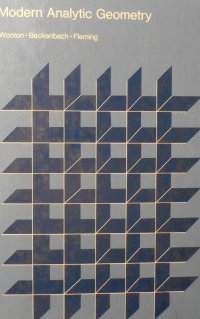
Ebook: Modern Analytic Geometry
- Genre: Mathematics // Geometry and Topology
- Tags: Analytic Geometry, Vectors, Lines, Planes, Conic Sections, Transformation of Coordinates, Curve Sketching, Polar Coordinates, Linear Programming
- Year: 1981
- Publisher: Houghton Mifflin School
- Edition: 1
- Language: English
- pdf
We have written this book with the aim of providing a modern course in analytic
geometry for today’s students. The past decade has witnessed important changes
in the textbooks used for the study of algebra, geometry, and trigonometry.
It has become evident that the traditional course in analytic geometry should
also be changed to reflect in spirit, as well as in content, the changes that have
taken place in the study of mathematics.
This text is excellent preparation for the study of calculus and linear algebra.
It is also an interesting course of and by itself. The material allows for a con-
siderable amount of flexibility. Planned as a semester course, it might also be
used in special cases as the basis for a full-year course. Also, several different
semester courses are possible, depending on the preparation and aims of the
students. The large number of exercises allows ample opportunity for adjust-
ments in assignments, and the attention given to proof may be much or little.
Asterisks signal those exercises which are particularly demanding.
Interest is secured at the outset by a study of the algebra and geometry of
two-dimensional vectors, a topic new to many of the students. With this basis,
vector methods can then be used in developing the concepts and techniques of
analytic geometry. The student who continues his study of mathematics will
find it very advantageous to have a working knowledge of vectors, and the mate-
rial is inherently interesting even if one does not plan on future courses in mathe-
matics.
An understanding of the traditional Cartesian methods, however, is still
highly important to today’s students and, accordingly, we have been very careful
to include a thorough treatment of these methods in tandem with the vector
approach. We believe the course presented in this book gives students an
unusual opportunity to see how two apparently diverse branches of mathe-
matics are, in reality, closely related, and to appreciate the value of having
more than one method available for solving a given problem.
Study aids include such valuable lists as key trigonometric identities, funda-
mental properties of real numbers, important symbols, and a summary of
formulas from analytic geometry. Color is used functionally to call attention to
key concepts and processes and to clarify illustrative examples and diagrams.
Finally, students will enjoy the series of illustrated essays appearing at the
close of chapters. These essays were included to deepen and extend the student’s
interest in the subject and its applications.
geometry for today’s students. The past decade has witnessed important changes
in the textbooks used for the study of algebra, geometry, and trigonometry.
It has become evident that the traditional course in analytic geometry should
also be changed to reflect in spirit, as well as in content, the changes that have
taken place in the study of mathematics.
This text is excellent preparation for the study of calculus and linear algebra.
It is also an interesting course of and by itself. The material allows for a con-
siderable amount of flexibility. Planned as a semester course, it might also be
used in special cases as the basis for a full-year course. Also, several different
semester courses are possible, depending on the preparation and aims of the
students. The large number of exercises allows ample opportunity for adjust-
ments in assignments, and the attention given to proof may be much or little.
Asterisks signal those exercises which are particularly demanding.
Interest is secured at the outset by a study of the algebra and geometry of
two-dimensional vectors, a topic new to many of the students. With this basis,
vector methods can then be used in developing the concepts and techniques of
analytic geometry. The student who continues his study of mathematics will
find it very advantageous to have a working knowledge of vectors, and the mate-
rial is inherently interesting even if one does not plan on future courses in mathe-
matics.
An understanding of the traditional Cartesian methods, however, is still
highly important to today’s students and, accordingly, we have been very careful
to include a thorough treatment of these methods in tandem with the vector
approach. We believe the course presented in this book gives students an
unusual opportunity to see how two apparently diverse branches of mathe-
matics are, in reality, closely related, and to appreciate the value of having
more than one method available for solving a given problem.
Study aids include such valuable lists as key trigonometric identities, funda-
mental properties of real numbers, important symbols, and a summary of
formulas from analytic geometry. Color is used functionally to call attention to
key concepts and processes and to clarify illustrative examples and diagrams.
Finally, students will enjoy the series of illustrated essays appearing at the
close of chapters. These essays were included to deepen and extend the student’s
interest in the subject and its applications.
Download the book Modern Analytic Geometry for free or read online
Continue reading on any device:

Last viewed books
Related books
{related-news}
Comments (0)